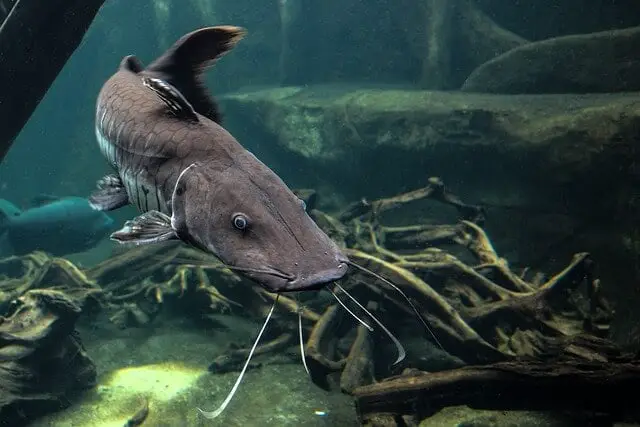If you’ve ever seen a catfish, you may wonder where the creature got its name from. All it takes is one look, and you will know that it is because of its whiskers, whiskers that make us think of a cat.
But then, another thought comes to mind, or rather, a question, and that is, why do catfish have whiskers? And if you landed on this article, we’re guessing this was the question on your mind today.
If yes, read on, for this article attempts to tell you all about the same.
Why Do Catfish Have Whiskers?

So, what are catfish whiskers for? Catfish have whiskers to help them feel their surroundings as well as smell and taste things around them. Or in other words, the whiskers of a catfish serve as taste buds and olfactory sensors, which help the catfish navigate their way in the water and find their food.
Basically, the whiskers are a special organ of the catfish, an organ that serves as feelers through which it senses its surroundings, all complete with skin on it. That is to say, they are very much a part of the body that the catfish can feel.
How do catfish barbels work?
These are thin and long tendrils that one finds on the sides of a catfish’s mouth, very much like the whiskers that one finds on the mouth of a cat, with the only difference being that these are not whiskers of hair.
It is, for this reason, they are actually called barbels, though they are often known as whiskers because of their resemblance to the whiskers that are found on a cat.
These, on the other hand, are a part of the catfish’s body, coated with cells that give them a sense of taste and smell. In neither words, they are loaded with olfactory senses and taste buds and make up for a catfish’s poor eyesight.
Do All Catfish Have Barbs?
Not all catfish have barbs. In fact, there are many different species of catfish, and each species has its own unique characteristics. Some species of catfish have barbs, while others do not.
Catfish come in varieties of species, some small, some larger than a cat, and some even larger than a kid, which means they are available in a variety of sizes, and the length of their barbels can differ with the kind of their species.
While a catfish’s barbels are normally about one to two inches, there are variations, with some that can even go up to six feet in size.
In fact, there are catfish that can go up to the size of a bear. However, it is the smaller catfish that one needs to be more cautious about, not so much because of their barbels as the other parts of their bodies.
Must Read: Do Fish Have Periods?
Can Catfish Whiskers Sting You?

Often there’s a lot of thought that holding a catfish’s whiskers can produce a kind of sting, but this is highly unlikely and most often a myth.
What does sting, on the other hand, are the fins that are located on the head of the catfish, and now this is something one needs to be careful with.
The fins, though soft, come with a hard spine that ends at a point that is sharp and appears to be a sting.
So, in reality, this is not really a sting, yet, it can be dangerous for the venomous glands that they contain, which can be more harmful than a sting.
Are Catfish Whiskers Poisonous?
The whiskers of a catfish are not poisonous, but as seen above, the spine on the fins are, and so, while one can have all the fun exploring the catfish’s whiskers, it is still important to be careful in the process, keeping an eye out on the spine.
As seen above, the whiskers are merely made of skin and though long and sharp, do not sting. They may give the person holding them a little poke at the most, which is harmless, unlike a dangerous sting.
And while they look scary, they contain absolutely no toxins and are definitely not poisonous.
Can Catfish Whiskers Hurt You?
No, a catfish does not hurt, and neither do its whiskers. Their scary appearance does a good job of keeping away their predators, but humans need not worry.
On the contrary, the whiskers of a catfish are soft and pliable, which means that they bend with ease. In fact, catfish are harmless and can be played with, as long as you remember what was said above and beware of its fins.
What Happens If You Touch A Catfish Whiskers?
Touch a catfish’s whiskers, and you will find it very similar in feel to the whiskers of a cat.
The creature, in return, also reacts in the same way, replying with a kind of sound that is very similar to that of the purring of a cat.
In other words, touching a catfish’s whiskers will, in every way, remind and make you feel like you are playing with a cat.
Interesting Facts About Catfish Whiskers!

With that, here are some interesting features of the whiskers of a catfish:
The whiskers of a catfish can grow, especially if they are damaged, and this means there is no problem in such a case. However, how well they grow depends on several factors like the quality of the water they are in, the nutrition they receive, and even their age.
It is for this reason that there is also a chance that the whiskers may, at times, not grow back, and hence, one needs to also handle them with care.
Catfish can have up to eight whiskers, which you can see when you interact with them. These are located around the corners of the mouth, with two on the snout and four that are found under the chin.
From all that has been said above, one can easily conclude that the whiskers of a cat are very sensitive. After all, the catfish feels with the help of it.
They can, in fact, even detect changes in their surroundings with it. So, while it’s ok to play with the whiskers of a catfish, one also needs to remember to be gentle with it.
No, the answer is obvious. In fact, the catfish gets its name from the animal that is known for its whiskers, the cat. And then there are also rabbits, rats, seals, and various other mammals that come with whiskers, those which are similar to a cat.
Finally, one of the most interesting things about a catfish’s whiskers is their size, as they can come in a variety of sizes just as there are a variety of species.
So, studying a catfish can never get boring with the variety that you will come across and, with that, the variety of sizes in which their whiskers come.
Final Thoughts: Why Do Catfish Have Whiskers?
So, now that you know all about a catfish and its whiskers, go ahead and explore the next time, and yet keep all that we told you in mind.
For one, make sure that you know how to hold a catfish properly. Know what it is that you should be scared of and what you should not.
And then, you can go ahead and enjoy playing with a catfish, taking pictures, and then uploading it all, for other catfish lovers to also read about your experience with a catfish.

